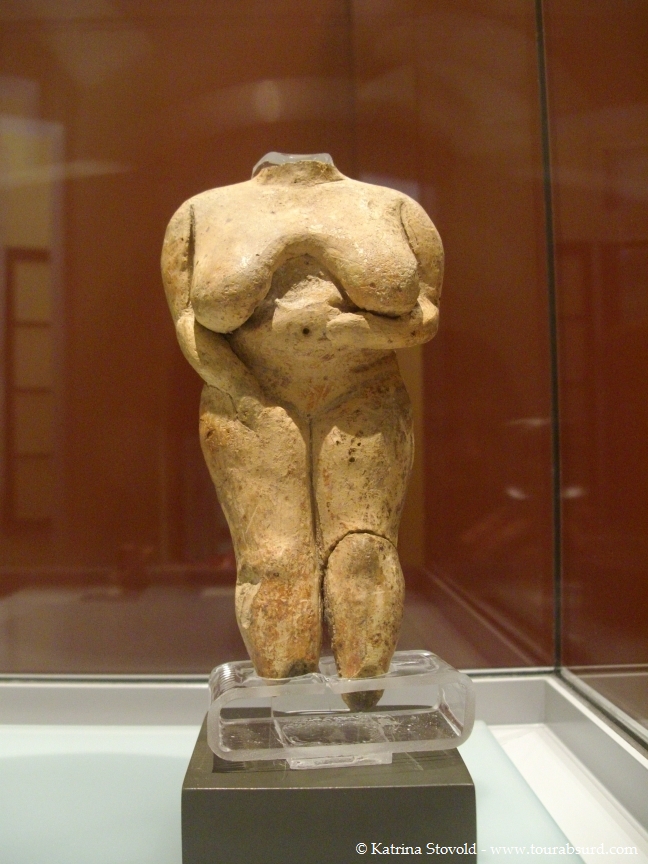Valletta, Malta
Surprisingly few people know where to find Malta on a map. (Common reactions include, "Oh, like the Maltese Falcon?" or mine, "I had a Bichon Frise, which are descended from the Maltese breed! Err…") Even fewer know that what may be the oldest freestanding buildings in the world, megalithic temples, are present on 2 of Malta's main islands, Malta and Gozo.
In addition to the UNESCO World Heritage sites, there are several other locations of archaeological and paleontological interest, yielding thousands of fossils, as well as ancient art and religious objects, to modern scientists for study and reflection. Some of the most significant finds, including objects over 7,000 years old, are on display in the National Museum of Archaeology.
Venus of Malta, discovered at Ħaġar Qim temple.
Two other great finds on display include the Sleeping Lady and the Colossal Lady. I can only find online reference to the latter as one of the "fat lady" sculptures of Malta, but I'm pretty sure she was called "colossal." I have a picture of myself standing next to the original (there is a reproduction/partial restoration version at the Tarxien temple where she was unearthed), but all this "fat lady" stuff is more than enough motivation for me NOT to share the photos that include moi. Ahem. …oh, ok. Here's a link to a photo of the Colossal Lady in the museum — sans me.
I think most non-Maltese people go to Malta for the sun, beaches, sailing, fishing, and giant water tanks. The temples and museums, however, are not to be missed. You can even go to a cave where bones of dwarf elephants were discovered — DWARF ELEPHANTS! How cool is that?!?
So, yeah — find Malta on a map and visit! You'll feel extra clever for a long time. ;)

For those who don’t know , here in Malta we have the oldest temples in the world , the Maltese free standing monuments dating back to about 3,500 BC . 4 from the 10 oldest temples in the world , which are the Ggantija temples , Hagar Qim , Mnajdra and the Hypogeum which is the only prehistoric underground temple in the world are all here in Malta. The earliest evidence of human activity in Malta dates back to about 5,000BC in Skorba, where evidence of a Neolithic village dating back to 5,000 to 4,000BC has been unearthed.
Want to see and know more , visit the Maltese Islands … :-)
Thank you for that bit of history. I have heard that the age of the temples has been in dispute for some time, with some parties claiming that they may be as old as 30,000 years. Amazing!
Wow, that Venus doesn’t look anything like Venus statues we’ve seen so far!
Really? Now I’m wondering what other Venuses (Veni?) you’ve seen. :D
lol Katrina you crack me up. I’ve seen the statue before – I think it is fascinating.
Yay! Mission accomplished! :D
Now THERE’s a Venus I can get behind! How did societies go from worshiping voluptuous female figures to adoring super-skinny girls? Ah, well. I keep thinking my time will come yet again. Great post, btw.
I often ask myself that same question, especially when I see the poor, hungry-looking women and girls clunking unnaturally down the runway. I really want to just offer them a sandwich!
Great article! Thanks for sharing this with me. I had no idea Malta was so rich with history! I’ll have to add it to my bucket list now.
I’m so happy to hear that, Shawn. Really, comments like this make my day. Thanks! :D
Dwarf elephants? Are those like ponies (but little elephants, of course)? I’m very intrigued! =)
Aparently Malta and Sicily, among others, used to be part of Africa. After the separation, the food supply was seriously reduced. Evolution kicked in and designed smaller elephants!
https://media.tourabsurd.com/images/dwarf_elephant_skeleton.jpg
https://en.wikipedia.org/wiki/Dwarf_elephant
(I tried to type more, but my browser (or Disqus) got persnickety.)
Ponies and horses are really just short vs. tall (over 14.2 hands = horse, under = pony). Miniature horses might be closer to the mark, though they are the result of intentional, selective breeding. The elephants came about through “insular dwarfism”: https://en.wikipedia.org/wiki/Insular_dwarfism